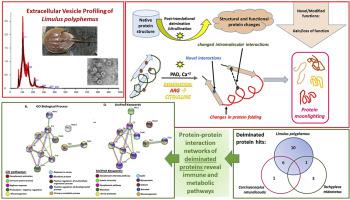当前位置:
X-MOL 学术
›
Dev. Comp. Immunol.
›
论文详情
Our official English website, www.x-mol.net, welcomes your
feedback! (Note: you will need to create a separate account there.)
Post-translational protein deimination signatures and extracellular vesicles (EVs) in the Atlantic horseshoe crab (Limulus polyphemus).
Developmental & Comparative Immunology ( IF 2.7 ) Pub Date : 2020-04-23 , DOI: 10.1016/j.dci.2020.103714 Timothy J Bowden 1 , Igor Kraev 2 , Sigrun Lange 3
Developmental & Comparative Immunology ( IF 2.7 ) Pub Date : 2020-04-23 , DOI: 10.1016/j.dci.2020.103714 Timothy J Bowden 1 , Igor Kraev 2 , Sigrun Lange 3
Affiliation

|
The horseshoe crab is a living fossil and a species of marine arthropod with unusual immune system properties which are also exploited commercially. Given its ancient status dating to the Ordovician period (450 million years ago), its standing in phylogeny and unusual immunological characteristics, the horseshoe crab may hold valuable information for comparative immunology studies. Peptidylarginine deiminases (PADs) are calcium dependent enzymes that are phylogenetically conserved and cause protein deimination via conversion of arginine to citrulline. This post-translational modification can lead to structural and functional protein changes contributing to protein moonlighting in health and disease. PAD-mediated regulation of extracellular vesicle (EV) release, a critical component of cellular communication, has furthermore been identified to be a phylogenetically conserved mechanism. PADs, protein deimination and EVs have hitherto not been studied in the horseshoe crab and were assessed in the current study. Horseshoe crab haemolymph serum-EVs were found to be a poly-dispersed population in the 20-400 nm size range, with the majority of EVs falling within 40-123 nm. Key immune proteins were identified to be post-translationally deiminated in horseshoe crab haemolymph serum, providing insights into protein moonlighting function of Limulus and phylogenetically conserved immune proteins. KEGG (Kyoto encyclopaedia of genes and genomes) and GO (gene ontology) enrichment analysis of deiminated proteins identified in Limulus revealed KEGG pathways relating to complement and coagulation pathways, Staphylococcus aureus infection, glycolysis/gluconeogenesis and carbon metabolism, while GO pathways of biological and molecular pathways related to a range of immune and metabolic functions, as well as developmental processes. The characterisation of EVs, and post-translational deimination signatures, revealed here in horseshoe crab, contributes to current understanding of protein moonlighting functions and EV-mediated communication in this ancient arthropod and throughout phylogeny.
中文翻译:

大西洋鲎(Limulus polyphemus)中的翻译后蛋白质去亚化特征和细胞外囊泡(EV)。
鲎是一种活化石,是一种海洋节肢动物,具有不同寻常的免疫系统特性,也被商业开发。鉴于其可追溯到奥陶纪时期(4.5 亿年前)的古老地位、其在系统发育中的地位和不寻常的免疫学特征,鲎可能为比较免疫学研究提供有价值的信息。肽基精氨酸脱亚胺酶 (PAD) 是钙依赖性酶,在系统发育上是保守的,并通过将精氨酸转化为瓜氨酸而导致蛋白质脱亚胺。这种翻译后修饰会导致蛋白质结构和功能发生变化,从而导致健康和疾病中的蛋白质兼职。PAD 介导的细胞外囊泡 (EV) 释放调节,这是细胞通讯的关键组成部分,此外,已经确定是一种系统发育上保守的机制。迄今为止,尚未在鲎中研究 PAD、蛋白质去亚化和 EV,并在当前研究中对其进行了评估。马蹄蟹血淋巴血清 EV 被发现是 20-400 nm 大小范围内的多分散种群,大多数 EV 落在 40-123 nm 范围内。鉴定出关键免疫蛋白在鲎血淋巴血清中被翻译后脱去,提供了对鲎的蛋白质兼职功能和系统发育保守免疫蛋白的见解。KEGG(京都基因和基因组百科全书)和 GO(基因本体论)对鲎中鉴定的脱亚蛋白的富集分析揭示了与补体和凝血途径、金黄色葡萄球菌感染、糖酵解/糖异生和碳代谢,而生物和分子途径的 GO 途径与一系列免疫和代谢功能以及发育过程有关。在鲎中揭示的 EV 表征和翻译后去亚化特征有助于目前了解这种古代节肢动物和整个系统发育中的蛋白质月光功能和 EV 介导的通信。
更新日期:2020-04-23
中文翻译:

大西洋鲎(Limulus polyphemus)中的翻译后蛋白质去亚化特征和细胞外囊泡(EV)。
鲎是一种活化石,是一种海洋节肢动物,具有不同寻常的免疫系统特性,也被商业开发。鉴于其可追溯到奥陶纪时期(4.5 亿年前)的古老地位、其在系统发育中的地位和不寻常的免疫学特征,鲎可能为比较免疫学研究提供有价值的信息。肽基精氨酸脱亚胺酶 (PAD) 是钙依赖性酶,在系统发育上是保守的,并通过将精氨酸转化为瓜氨酸而导致蛋白质脱亚胺。这种翻译后修饰会导致蛋白质结构和功能发生变化,从而导致健康和疾病中的蛋白质兼职。PAD 介导的细胞外囊泡 (EV) 释放调节,这是细胞通讯的关键组成部分,此外,已经确定是一种系统发育上保守的机制。迄今为止,尚未在鲎中研究 PAD、蛋白质去亚化和 EV,并在当前研究中对其进行了评估。马蹄蟹血淋巴血清 EV 被发现是 20-400 nm 大小范围内的多分散种群,大多数 EV 落在 40-123 nm 范围内。鉴定出关键免疫蛋白在鲎血淋巴血清中被翻译后脱去,提供了对鲎的蛋白质兼职功能和系统发育保守免疫蛋白的见解。KEGG(京都基因和基因组百科全书)和 GO(基因本体论)对鲎中鉴定的脱亚蛋白的富集分析揭示了与补体和凝血途径、金黄色葡萄球菌感染、糖酵解/糖异生和碳代谢,而生物和分子途径的 GO 途径与一系列免疫和代谢功能以及发育过程有关。在鲎中揭示的 EV 表征和翻译后去亚化特征有助于目前了解这种古代节肢动物和整个系统发育中的蛋白质月光功能和 EV 介导的通信。











































 京公网安备 11010802027423号
京公网安备 11010802027423号